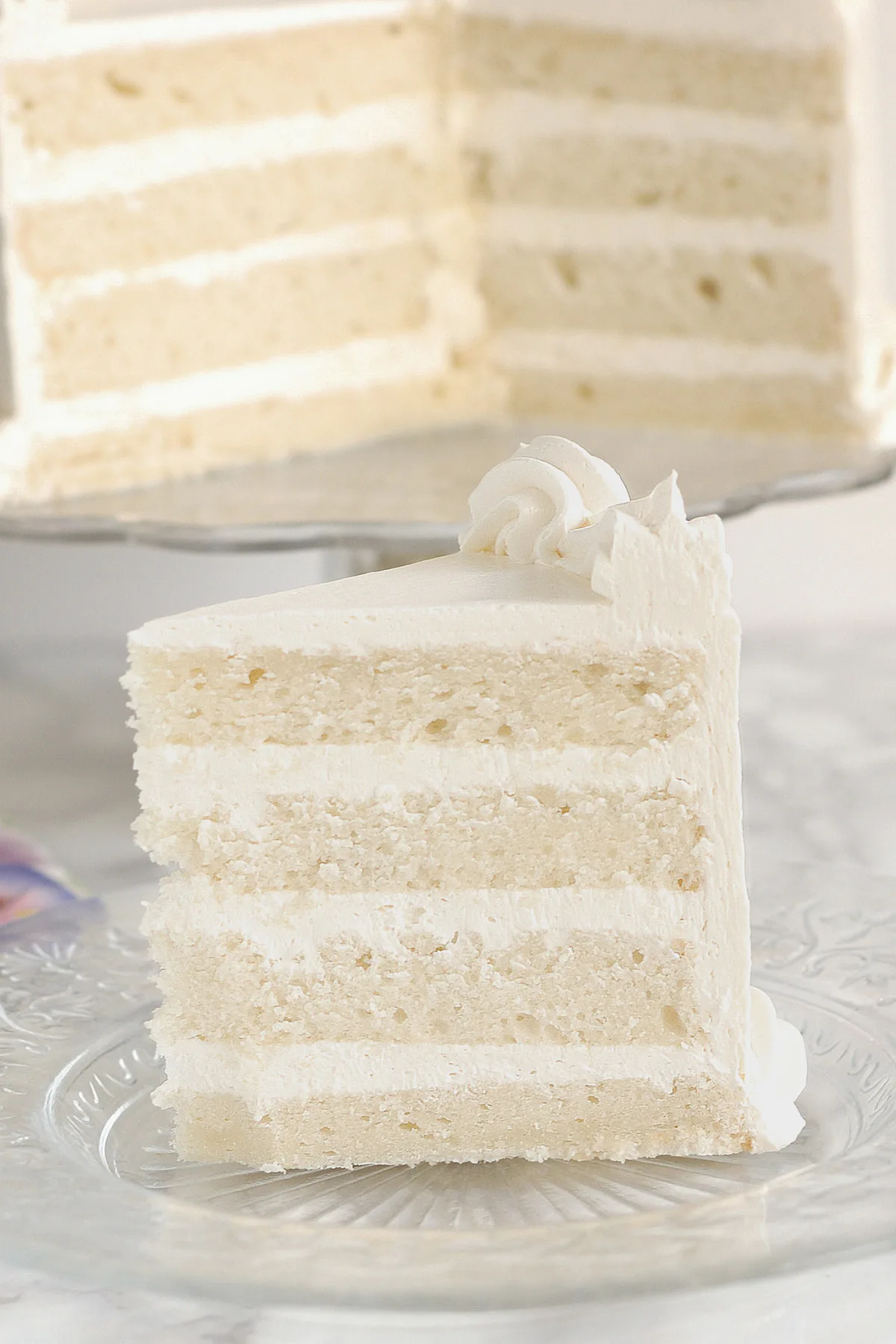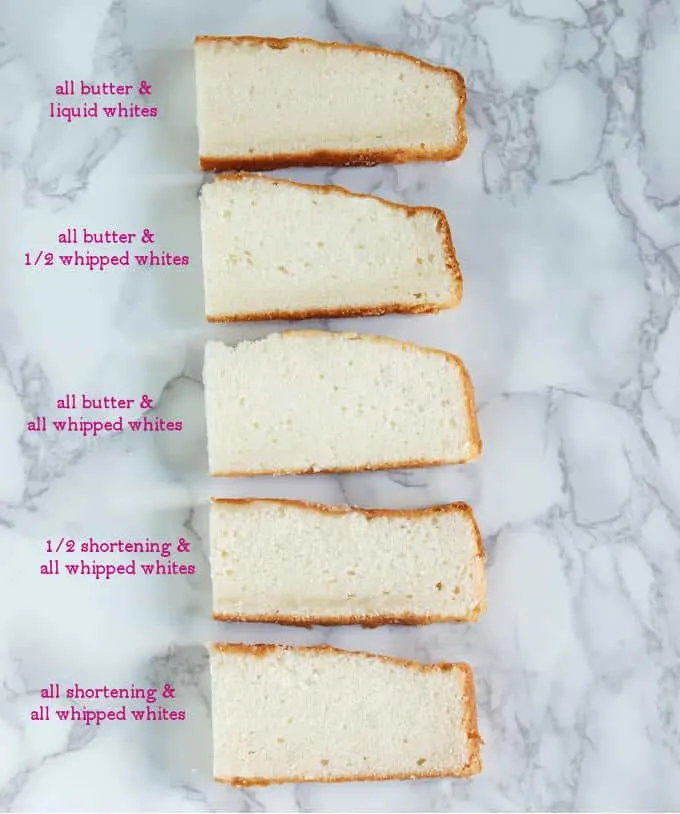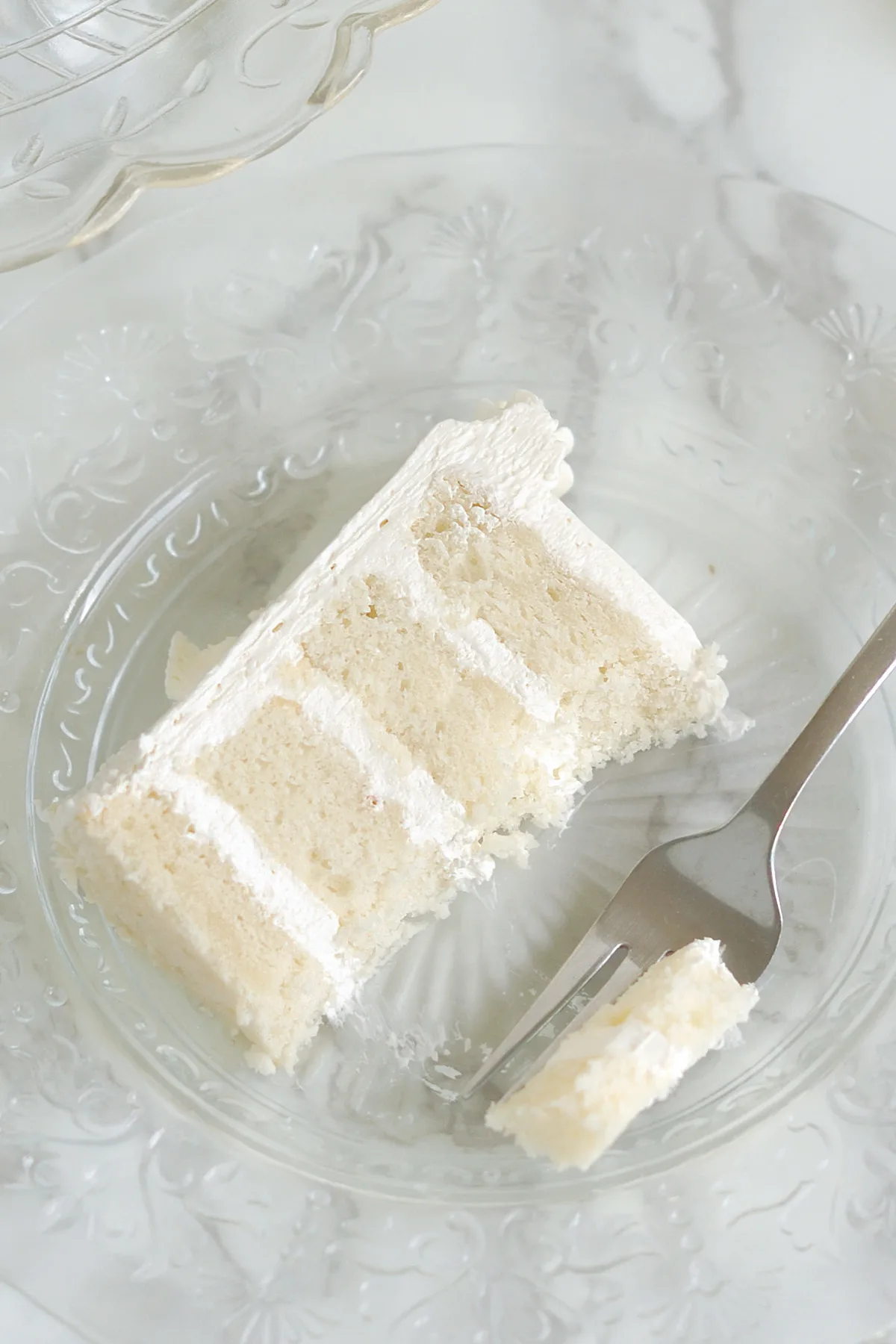Developing and testing a White Cake Recipe
In this article I detail exactly how I developed and tested my white cake recipe.
Have you ever taken a bite of a beautiful white cake only to be disappointed by it’s rubbery texture and bland taste? With the proper ingredients and mixing technique you can make velvety soft and tender White Cake at home.
Jump to recipe for the Best White Cake

A reader told me she’d gotten some bad advice on the internet (shocking!) about making substitutions in a cake batter. She wanted to make a moist white cake, but her first attempt was a failure.
I gave her some suggestions to adapt my Vanilla Butter Cake recipe and she got a better, but not perfect, result. So of course this got me thinking that it was time to get in the kitchen and run a few experiments. Yipee!
I love a good kitchen experiment, so I’m always happy to have an excuse to take apart a recipe and tweak it to get the desired outcome.
I did extensive research and testing into what makes a good cake recipe for my “Cake Batter” series. I knew that information would help me create a really soft and tender white cake that still had good vanilla flavor.
I detailed exactly how I use the Baker’s Formula create my cake recipes in this post. Take a look, there’s tons of really great information.
I did 5 recipe tests to make the best White Cake
Egg yolks add fat and flavor to vanilla cake. The problem with a white cake is how to eliminate the yolks without making the cake rubbery and tasteless.
Eggs whites are full of protein, which helps create the structure of a cake. But too much structure can make a cake rubbery or tough, which is most often the problem with cakes made with only egg whites.
I won’t go into all the details here. Any of you baking geeks who want in depth information about how eggs work in cake batter can visit the “Eggs in Cake Batter” class.
- The first change I made to the Vanilla Cake recipe was to eliminate the yolks and use more whites; 6 egg whites instead of 6 yolks+3 whites.
- I kept the sour cream in the recipe because it tenderizes the cake, adds flavor and of course does not interfere with the white color.
- For the first 3 test cakes I changed how I mixed the ingredients together. Mixing technique can make a BIG difference in a cake’s texture.
- Check out the “Cake Batter Mixing Methods” class to find out why I use the “Reverse Creaming” technique for my butter cakes.
Reverse creaming makes the softest white cake
- For the first cake test I mixed the ingredients with the Reverse Creaming method, and I added the liquid egg whites directly into the batter.
- For the second cake test I mixed half the egg whites into the batter as a liquid, and whipped and the other half of the whites and folded them into the batter.
- For the third cake test I whipped all 6 egg whites and folded them into the batter.
You can see the difference in the first three cakes in the photo. The cake made with liquid whites had a very tight crumb and the cake with whipped whites had a lighter, more open crumb.
But even more importantly, the cake made with the whipped whites was much softer and more velvety than the other two cakes. That’s not really surprising.

Why whipping the Egg Whites makes a cake softer
Whipping egg whites has the same effect as cooking whites- the proteins unfold, reattach and trap water. Since whipped whites are already partially “cooked” they don’t contribute as strongly to the structure of the cake.
In my testing for the “Eggs in Cake Batter” class, I found that a cake has a softer texture when the whites were whipped and folded into the batter. The tradeoff is that the cake will settle and can shrink slightly as it cools. For me the soft texture of the cake is well worth the shrinking.
Ok, now that I had the technique down, I wanted to see if making changes to some of the other ingredients could change the color or texture of the cake.
Next I would focus on the other “yellow” ingredient in the recipe, the butter.
The best fat to use for white cake:
- I made one cake with 1/2 butter and 1/2 shortening and the other cake with all shortening and no butter. There wasn’t much of a difference in color by substituting the butter with shortening. The textures were also pretty similar.
- I definitely preferred the taste of the all butter cake to either of the cakes with shortening. But I know I have a deep love for butter which might have colored my opinion.
- I had my husband do a blind tasting of the three cakes and he also liked the butter cake best. He described the flavor as “more creamy”. Well, yea!
So it’s butter for the win, again!
(If your butter has a very yellow color you can substitute all or some of the butter with shortening to get a whiter crumb. The butter cake tasted better, but the others tasted good. Once they’re filled with buttercream the difference would be less noticeable.)
Testing the vanilla extract versus vanilla sugar in white cake:
- I made a cake using vanilla sugar instead of vanilla extract to see if that would affect the color or flavor of the cake.
- The flavor was good with both, but there really was not a noticeable difference in whiteness without the vanilla.
- I don’t recommend “clear” vanilla since it’s not really vanilla at all.
So, there you have it! A beautiful classic white cake that tastes as good as it looks. It’s moist from the sour cream and tender because of the mixing technique.
Keep those questions coming! I love them!


For the whipped egg whites, would this still work if I made the batter the night before? As long as the recipe has baking powder (or I can adapt it to), I prefer to rest the batter ~24H for rise, texture, and depth of flavor.
I haven’t tried this so couldn’t definitively say without testing. Do you generally rest cake batter, or do you mostly use the resting method with bread, muffins and cookies. Texture, rise and flavor is quite different for bread, muffins and cookies than for a delicate cake. Bread is generally made with high protein flour and cookies and muffins are generally made with medium protein AP flour. Cake batter is made with low protein cake flour. The reason for holding bread dough is for the yeast to ingest the sugars in the dough and convert it to flavorful acids. Part of the reason for holding cookie and muffin batter is to give the flour time to absorb moisture in the batter. Because this cake batter is a butter based the texture is going to change during the night. It will thicken and it may become difficult to fold in the egg whites evenly without deflating. Also, the baking powder will lose some of it’s oomph. “Double acting” baking powder has an initial release of carbon dioxide when it meets the moisture in the batter and another in the heat of the oven. Leaving the batter overnight will sacrifice that initial burst of gas. I mean, there are many, many factors involved.
I’ve struggled with making cakes for so long the way that you describe what each step does for the cake helps me so much and I feel like I’m finally after two years of trying to bake really understanding how to make a good cake your vanilla cake recipe that is reverse creamed is beautiful. I appreciate the time and effort that you put into this. You truly have opened my eyes And taught me the science behind the baking and really plugged in whatever puzzle piece was missing with that thank you so much